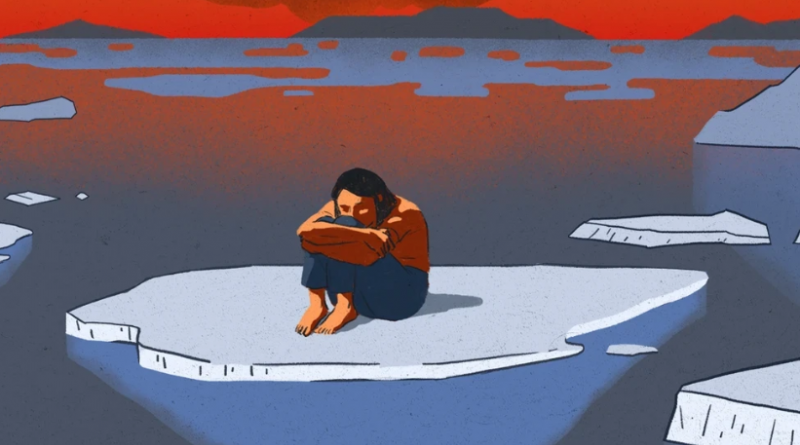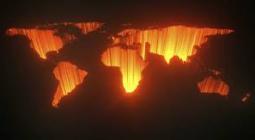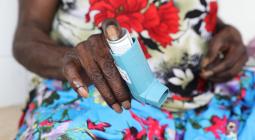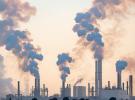People of Colour Experience Climate Grief More Deeply Than White People.

We are not only disproportionately affected by the climate crisis, but we carry a pain that comes from a long history of racial terror.
When the wildfires hit Australia last year, Bee Cruse was horrified at the sight of the red sky, the black ash falling like snow, and the smoke choking the whole East Coast.
The fires were a direct reminder of the British genocide against Aboriginal and Torres Strait Islander people like her, and the tearing of them from country and their traditional ways of land management.
In an article for Vox, Cruse, a Wiradjuri, Gomeroi, and Monaroo-Yuin storyteller, told me, “We see and feel the spirit of our animals and our land; they are our ancestor spirits. We don’t own country, country owns us; we come from her to protect her. When country hurts, we hurt. When our animals, our spirit cousins, cry, we cry.”
What Cruse was describing was climate grief, a psychological phenomenon that affects Black and Indigenous peoples, and other people of colour, in uniquely devastating ways.
Just as we are seeing with theCOVID-19 outbreak, environmental racism forces people of colour, especially Black and Indigenous peoples, to bear the brunt of global disaster. We are not only disproportionately affected by the climate crisis—breathing in more pollution, living in communities with higher temperatures, suffering from more medical conditions, experiencing more natural disasters, and being displaced at much higher rates—but we carry the pain of the climate crisis deep inside us.
In its 2014 report, Beyond Storms & Droughts: The Psychological Impacts of Climate Change, the American Psychological Association (APA) found that the climate crisis was affecting human mental health across the globe.
Anyone can experience climate grief, regardless of their identity. But for us, our grief—and our anger—is rooted in centuries of painful history, and the current ecological violence hurled at our communities.
“Just like other stressors that people of colour experience, ecological grief is often magnified,” said Dr. Tyffani Dent, a licensed psychologist and author, in an interview.
“People of colour know…society is going to make sure we’re impacted first, and impacted the hardest,” Dent said.
The climate crisis is linked to our oppression
Xiye Bastida, a youth climate activist, a member of the Indigenous Mexican Otomi-Toltec nation, and an organizer of Fridays for Future, says that her climate grief is deeply tied to her Indigenous identity.
“For Indigenous people, climate grief comes from when they’re first displaced by fossil fuel companies, by drilling, by fracking infrastructure that makes Indigenous communities be moved from their place of origin, their place that they have a relationship with. (Our) relationship with the land is the first thing that we care about,” Bastida said.
For Black and Indigenous peoples, you could argue that the history of our oppression is the story of the Anthropocene itself—the current geological age defined by the dominant influence that human activity has had on mass extinction, climate, and the environment. Without colonization, the trans-Atlantic slave trade, and the genocide and oppression of Indigenous peoples around the world, we likely would be living in a different reality.
Research has bolstered the idea that white supremacy has led to the climate crisis. Scientists from University College London found that the mass genocide that accompanied the colonization of the Americas in the 15th century permanently altered Earth’s climate, due to “a huge swathe of abandoned agricultural land” that “pulled down enough carbon dioxide from the atmosphere to eventually chill the planet.”
Ravenous for the mass production of lucrative commodities such as salt, cotton, and sugar, the slavemasters and colonists stripped the land in what’s now known as Canada and the United States, the Caribbean, and South America, murdering countless Africans and Indigenous peoples along the way.
Worldwide, the memory of indescribable racial terror informs the climate grief of our people.
For many people of colour, their experiences with climate grief propel them into activism and politics. Andom Ghebreghiorgis, Congressional candidate for New York’s 16th District, recalls a trip he took to see his family in Eritrea in 2017, travelling from the capital Asmara to Keren.
“We were leaving the Highlands and the mountains, going towards lower lands. My uncle was pointing out trees that another one my uncles—when he was governor of the area about 20 years ago—had planted as a reforestation effort,” Ghebreghiorgis told me. “But there weren’t many trees anymore. It was brown everywhere, and almost the entire land had turned into dust.”
Seeing that, Ghebreghiorgis said, was a jolting first-hand experience of Africa’s desertification, felt most by people who have not contributed anything to global climate change.
That’s why a central tenet of his campaign is advocating for a Global Green New Deal. “The entire world needs to be on the same page, whether that’s ending fossil fuel subsidies here in America and China, or ending desertification in the global South,” Ghebreghiorgis said.
Our grief motivates action
Our grief can help us stay motivated to do this work. Mary Heglar, a Black climate justice essayist and writer-in-residence at Columbia University, says that climate rage is a normal response to these injustices and continued violence.
“I started writing because of rage, to be quite honest. And the rage, the grief, the love... all of these emotions drive my writing,” Heglar said.
Heglar, whose work is rooted in her experience as a Black person from the American South, said her anger “has been a really powerful outlet to keep me from cycling back into depression and shock. But I still go back there sometimes. I have nightmares a lot.”
Those nightmares are a daily reality for people of colour, who are too often left behind. When ecological disasters strike, white people often receive resources long before those resources reach communities of colour. A March 2019 NPR report found that out of more than 40,000 records in the Federal Emergency Management Agency (FEMA) database, a staggering 85 percent of post-disaster buyouts went to white, non-Hispanic families.
In contrast, President Donald Trump recently released $16 billion in aid for Puerto Rico, more than two years after Hurricane Irma, but it comes with severe and unreasonable restrictions, like barring them from paying its $15 an hour minimum wage to workers on federally funded projects.
We cope differently, too
For some of us, we find ways to handle grief by building community through engagement with spiritual practices. Kritee (Kanko) PhD, a climate scientist and the co-founder and executive director of Boulder Eco-Dharma Sangha, specializes in climate grief, particularly among women of colour.
Kritee experiences climate grief all the time, she said. “I cry. I’ve done enough grief work, that I’m not afraid of my own tears or those of anyone else. It’s like bathing. Just as I bathe my body, I have to bathe my heart with my own tears.”
In the climate grief retreats she leads, she tries to provide people with tools to bring climate grief work back to their own communities. “We need more and more people who can hold space for themselves and others,” Kritee said. “The traditional psychotherapy model, which is so expensive and unavailable to many people, is not going to do what needs to be done in these times.”
Bastida, whose hometown in Mexico experienced a devastating flood, knows how these tears can move us to action.
“Because Black, Indigenous, and brown communities are the most affected, it is indicative of not only more grief, but also more action. My personal climate grief was addressed when I started being an activist, having a purpose, (saying) ‘I’m not gonna let this happen.’”
"Hope is such a white concept."
Heglar says that too often, the white-led climate community leans on the idea of hope, which can lead to inaction.
Hope is “such a white concept,” Heglar said. “You’re supposed to have the courage first, then you have the action, then you have the hope. But white people put hope at the front. Their insistence on hope for all of these years has led to exactly where? Nowhere.”
Working in the climate movement while trying to process climate grief can be difficult for people of colour, whose voices are so often silenced and ignored.
“There’s a certain loneliness that comes with being a climate person,” Heglar said. “Then there’s an extra layer of loneliness that comes with being a climate person of colour, because you’re just stuck in this perpetual position of trying to save white people from themselves. And it’s so fucking exhausting.”
But for Heglar, that feeling has been relieved somewhat by finding ways to help one another heal. “In 2019, people of colour really took up space in the climate movement in a way that had never been done before; we made our presence known. And so that has (made me) feel a lot less lonely,” she said.
People of colour are connected by historical trauma. And when we come together and share our experiences, we can help reshape this world into something new.
As Kritee said, “We are part of a river of grief. And we are never alone.”
Nylah Burton is a writer based in Washington D.C., who covers mental health, climate, and race. Follow her on Twitter.
14 May 2020
VICE





